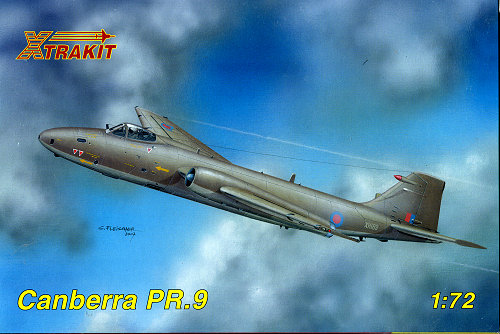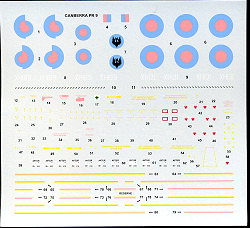
Xtrakit 1/72 Canberra PR.9
| KIT: | Xtrakit 1/72 Canberra PR.9 |
| KIT #: | XK72004 |
| PRICE: | $31.45 at GreatModels |
| DECALS: | Two options |
| REVIEWER: | Scott Van Aken |
| NOTES: | New Mold |

| HISTORY |
The Canberra had its origins in 1944 as a replacement for the unarmed high speed, high altitude de Havilland Mosquito bomber. Several British aircraft manufacturers submitted proposals. Among the companies short-listed to proceed with development studies was English Electric, a well-established industrial manufacturer with very little aircraft experience. A desperate need for bombers arose during the early years of World War II, when English Electric began to build the Hampden under license.
The new English Electric design team was headed by former Westland chief designer W. E. W. Petter. The aircraft was named Canberra after the capital of Australia by Sir George Nelson, chairman of English Electric, because Australia was the first export customer for the aircraft. In May 1945 a contract was signed, but with the post-war military reductions, the prototype did not fly until May 1949. It was a simple design, looking like a scaled-up Gloster Meteor with a shoulder wing. The fuselage was circular in cross section, tapered at both ends and, cockpit aside, entirely without protrusions; the line of the large, low aspect ratio wings was broken only by the tubular engine nacelles.
Although jet-powered and of all-metal construction, the Canberra design philosophy was very much in the Mosquito mould, i.e. provide room for a substantial bomb load, fit two of the most powerful engines available, and wrap it in the smallest, most aerodynamic package possible. Rather than devote space and weight to defensive armament — which historically could not overcome purpose-designed fighter aircraft — the Canberra was designed to fly fast and high enough to avoid air-to-air combat entirely.
The Canberra was designed for a crew of two, under a fighter-style canopy, but delays in the development of the intended automatic radar bombsight resulted in the addition of a bomb aimer's position in the nose. Wingspan and length were almost identical at just under 20 metres, maximum takeoff weight a little under 25 tonnes. Thrust was provided by a pair of 30 kN axial flow Rolls-Royce Avon turbojets.
In the autumn of 1945, Air Ministry specification B.3/45 requested production of four prototypes. Although construction began in early 1946, the first aircraft flew only on 13 May 1949. In the interim, the Air Ministry had already ordered 132 production aircraft in bomber, reconnaissance, and training variants. The prototype proved vice-free and required only a few modifications. A new glazed nose had to be fitted to accommodate a bombardier because the advanced bombing avionics were not ready for production, the engines were upgraded to more powerful Avon R.A.3s, and the distinctive teardrop-shaped fuel tanks were fitted under the wingtips.
The resultant Canberra B.2 first flew on 21 April 1950, and entered squadron service with Royal Air Force (RAF) 101 Sqn in May 1951. In a testament to the aircraft's benign handling characteristics, the transition program consisted of only 20 hours in the Gloster Meteor and three hours in the dual-control Canberra trainer. With a maximum speed of 470 kt (871 km/h), a standard service ceiling of 48,000 ft (14,600 m), and the ability to carry a 3.6 tonne payload, the Canberra was an instant success. It was built in 27 versions which equipped 35 RAF squadrons, and were exported to Argentina, Chile, Ecuador, Ethiopia, France, India, New Zealand, Pakistan, Peru, Rhodesia, South Africa, Sweden, Venezuela and West Germany.
A ceremony to mark the closure of No. 39 (PRU) Sqn, the RAF's last Canberra squadron and operator of the variant molded in this kit, took place at RAF Marham on Friday 28 July 2006. The ceremony included a flypast by a Canberra PR9 on its last ever sortie. RAF Canberras made their final flights on 31 July when three were delivered to their new home with Delta Jets at Kemble. They have been purchased by private agencies and will be kept serviceable pending developments which might include contract work.
After the Canberra left RAF service, the other full-time military operator, the Indian Air Force, announced the withdrawal of the Canberra from combat service from March 2007. The last Canberras operated by the Indian Air Force have retired after a 50 year career. Other Canberras are retained by the Air Force of Peru and several ex-RAF machines and RB-57s are flying in the US for research and mapping work.
About ten airworthy Canberras are in private hands today, and are a popular feature at flying displays.
| THE KIT |
 This is only the second PR.9 variant of the Canberra ever done in 1/72 scale injected plastic. The other, of course, was the venerable Matchbox kit of 30 or so years ago. This kit has molded the aircraft as it was in its very last days of operation (at least, I assume it is no longer in service), with all the updated mods in terms of antennas and such. There is a note in the instructions that this kit is based on drawings supplied by Aeroclub, which I found interesting.
This is only the second PR.9 variant of the Canberra ever done in 1/72 scale injected plastic. The other, of course, was the venerable Matchbox kit of 30 or so years ago. This kit has molded the aircraft as it was in its very last days of operation (at least, I assume it is no longer in service), with all the updated mods in terms of antennas and such. There is a note in the instructions that this kit is based on drawings supplied by Aeroclub, which I found interesting.
Molded in Sword's usual grey plastic, the kit has nicely engraved panel lines, butt joins for many of the parts, interior bulkheads to add some stiffness to the fuselage, no alignment pins. I've been told that there will be no other Canberras kitted by Xtrakit due to future releases in this scale by Airfix. Too bad as it may well be that the Airfix 1/72 offerings will be the old mold kits, complete with the issues of the originals in terms of the shape of the nose and engines. Much rather have new mold ones.
I generally look for molding faults and found a few with this one. The wheel wells are marred by an ejector pin tower in one and a hole in the other. The main gear doors have rather large sink areas on them that will take a couple of filler applications. Then you'll have to deal with some ejector towers on the larger pieces, but these are easily removed, unlike the ones in the wheel wells.
There are several clear bits. one for the canopy, one for the camera windows (this is a single molding that you mask the clear bits on), and two wing tip light housings. The PR.9 did not use tip tanks very often if at all. The cockpit is nicely done with raised, but somewhat soft detailing. There is a control wheel for the pilot and the bang seats are resin castings. Thanks to the separate nose, you have room for weight as you will need it. Tailplanes are butt joins but the wings slot into recesses in the fuselage.  Though the instructions show the intake and exhaust pieces being added after the wings are installed, my preference would be to attach these bits before gluing on the wings to enhance sanding and filler, should it be needed. This is especially true of the intake as it has a separate ring to be attached.
Though the instructions show the intake and exhaust pieces being added after the wings are installed, my preference would be to attach these bits before gluing on the wings to enhance sanding and filler, should it be needed. This is especially true of the intake as it has a separate ring to be attached.
Instructions are well done and, of course, reference Xtracolor paints, giving BS color references as appropriate. Basically you have your hemp over light aircraft grey, a color combo worn by most Canberras during the last 15 years or so of operation. There are two 39 Sq planes which are quite similar. One has a squadron badge on the fin while the other has a rather odd set of wing roundels. It is as if there were replacement panels installed that had different diameter roundels. Most curious. The decals are well printed and should provide no problems. A comprehensive data placement guide is provided for you. There are also some aftermarket options if you can find some of the older sheets from Modeldecal.
| CONCLUSIONS |
You are undoubtedly asking "can I chuck my Matchbox kit?" If you want a more modern and more detailed kit, then yes. This kit is very well done and manages to be done with no photo etch, no vacuformed bits, and only two resin pieces (the seats). While it probably won't be as easy to build as the Matchbox version, it will definitely make into a kit that will be a favorite for years to come.
| REFERENCES |
January 2008
You can find this and many other interesting kits atGreatModels. If you would like your product reviewed fairly and fairly quickly, please contact the editor or see other details in the